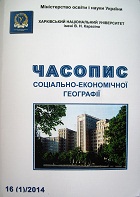Concrete and water. Searching for new possibilities of the tourisт function development in Tricity
Keywords:
tourist function, tourist product, Tricity.
Abstract
For many years sandy beaches and cultural heritage have almost guaranteed an unending stream of tourists visiting Gdańsk, Gdynia, Sopot and their close neighborhood. Nowadays those obvious attractions that are “given” to Tricity are not enough for lots of tourists who expect something more. Even an average participant in mass tourism has turned to experiences and more sophisticated forms of spending his or her free time – sunbathing and traditional sightseeing are not enough to attract more tourists to Tricity. The cities therefore need to develop a clear strategy regarding the way they want to develop tourism. In order to create a competitive tourist product Tricity’s authorities try to look for some opportunities of developing the tourist function. It is also a result of the anticipated increased competition between the cities of Tricity [12]. This paper presents two extraordinary examples of involving the private sector in the process of creation of the tourist product of two cities: Gdynia and Sopot.Downloads
Download data is not yet available.
References
1. Altkorn J., 1998. Marketing w turystyce. PWN, Warszawa.
2. Davidson R., 1993. Turystyka. Longman, London.
3. Framework guide to facilitate tourism investment: companion report 2011. Australian Government, Department of Resources, Energy and Tourism, 2012-10-01, http://www.ret.gov.au
4. Gaworecki W.W., 2003. Turystyka. PWE, Warszawa.
5. Getz D., 1993. The planning for tourism business district. Annals of Tourism Research, 20(3), pp. 583-600.
6. Gołembski G. editor, 1999. Regionalne aspekty rozwoju turystyki. PWN, Warszawa – Poznań.
7. Jędrysiak T., 2010. Wiejska turystyka kulturowa. PWE, Warszawa.
8. Kołodziejski J., 1995. Hipoteza kształtowania polityki przestrzennej państwa. In: Koncepcja przestrzennego zagospodarowania kraju, CVP. Warszawa.
9. Kowalczyk A., 2005. Nowe formy turystyki miejskiej. Prace i Studia Geograficzne, 35, pp. 155 – 197.
10. Kurek W. editor, 2007. Turystyka, PWN, Warszawa.
11. Liszewski S., 1995. Przestrzeń turystyczna. Turyzm, 5, 2, 87 – 103.
12. Sagan I., Canowiecki, 2011. Między integracją a konkurencją. Gdańsko – Gdyński Obszar Metropolitalny. Scholar, Warszawa.
13. Sea Towers, 2012-10-12, http://www.seatowers.pl
14. Sopot – Official Website, 2012-10-12, http://sopot.pl/eGmina/pl/
15. Urbis and Tourism and Transport Forum 2011, National Tourism Planning Guide: A best practice approach, Australian Government, Department of Resources, Energy and Tourism, 2012-10-01, http://www.ret.gov.au
16. Włodarczyk B., 2011. Processes of tourism space formation. Tourism, 21/1-2, 59 – 65, 59.
2. Davidson R., 1993. Turystyka. Longman, London.
3. Framework guide to facilitate tourism investment: companion report 2011. Australian Government, Department of Resources, Energy and Tourism, 2012-10-01, http://www.ret.gov.au
4. Gaworecki W.W., 2003. Turystyka. PWE, Warszawa.
5. Getz D., 1993. The planning for tourism business district. Annals of Tourism Research, 20(3), pp. 583-600.
6. Gołembski G. editor, 1999. Regionalne aspekty rozwoju turystyki. PWN, Warszawa – Poznań.
7. Jędrysiak T., 2010. Wiejska turystyka kulturowa. PWE, Warszawa.
8. Kołodziejski J., 1995. Hipoteza kształtowania polityki przestrzennej państwa. In: Koncepcja przestrzennego zagospodarowania kraju, CVP. Warszawa.
9. Kowalczyk A., 2005. Nowe formy turystyki miejskiej. Prace i Studia Geograficzne, 35, pp. 155 – 197.
10. Kurek W. editor, 2007. Turystyka, PWN, Warszawa.
11. Liszewski S., 1995. Przestrzeń turystyczna. Turyzm, 5, 2, 87 – 103.
12. Sagan I., Canowiecki, 2011. Między integracją a konkurencją. Gdańsko – Gdyński Obszar Metropolitalny. Scholar, Warszawa.
13. Sea Towers, 2012-10-12, http://www.seatowers.pl
14. Sopot – Official Website, 2012-10-12, http://sopot.pl/eGmina/pl/
15. Urbis and Tourism and Transport Forum 2011, National Tourism Planning Guide: A best practice approach, Australian Government, Department of Resources, Energy and Tourism, 2012-10-01, http://www.ret.gov.au
16. Włodarczyk B., 2011. Processes of tourism space formation. Tourism, 21/1-2, 59 – 65, 59.
Published
2014-11-14
Cited
How to Cite
Nowicka, K., & Szmytkowska, M. (2014). Concrete and water. Searching for new possibilities of the tourisт function development in Tricity. Human Geography Journal, 16(1), 51-55. https://doi.org/10.26565/2076-1333-2014-16-07
Section
Горизонти науки




